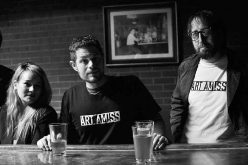Bike lane project gains attention
STACY RYBURN
sryburn@nwadg.com
A temporary bike lane that has neighbors divided appears to be slowing down cars as intended, but some adjustments may be needed, according to city officials and volunteers behind the project.
A protected bike lane has spanned Rolling Hills Drive from College Avenue to Old Missouri Road since November. The project was made possible through a grant with the Walton Family Foundation and spearheaded by nonprofit regional bicycle advocacy organization BikeNWA.
The lane goes from Rolling Hills through the Fiesta Square shopping center west to Appleby Road. Two similar projects went up in Siloam Springs and Springdale as part of a larger pilot program attempting to make travel more accommodating for bicycles and pedestrians.

NWA Democrat-Gazette/DAVID GOTTSCHALK
The temporary bike lanes are visible on Rolling Hills Drive Wednesday as traffic passes by in Fayetteville. BikeNWA, a regional bicycling advocacy organization, installed the temporary protected bike lanes at Rolling Hills Drive in November as part of a larger pilot project including Springdale and Eureka Springs paid for through a grant from the Walton Family Foundation.
What are people saying?
Fayetteville has received about 100 comments from the public since the installation, Communications Director Susan Norton said. About three-quarters of responses were negative and a quarter positive. Some residents are concerned about the width of the car lanes, others don’t like the way it looks, and others worried about it bottlenecking traffic, she said.
Mike Taylor, a resident of the neighborhood, said he feels hindering the traffic flow of cars to make room for bicycles isn’t the way to go. The city may classify Rolling Hills as a collector of traffic from main arteries, but in reality, it’s a thoroughfare, he said.
Traffic on each end snarls because cars don’t have enough room to maneuver, Taylor said. He said he didn’t mind the narrower lane widths, but any car that strays while going the speed limit risks hitting one of the temporary barriers.
Taylor said he’s lived in the neighborhood for about seven years and hasn’t seen much bicycle traffic along the painted bike lanes that used to be there.
“It’s a solution to a problem that doesn’t really exist,” he said. “They could’ve just left it as it was with the stripes.”
Most of the positive feedback from neighbors, some with children attending Butterfield Trail Elementary School, say they appreciate the traffic-calming effect of the project and improved safety for pedestrians and bicyclists, Norton said.
Chris Clanton, who lives on Rolling Hills Drive, said he’s very happy with the project. Cars have visibly slowed down, and with the reduction in lane widths, vehicles no longer try to go around each other when someone tries to turn, he said.
Additionally, Clanton said he feels safer getting around the neighborhood. He typically walks his dogs and pushes his baby in a stroller three times a day and would wait several minutes to cross the nearly 40-foot-wide street before the installation was put in, he said.
“Now I can actually walk on the bike lane to get to the south side of the neighborhood and walk around those streets,” he said.
Clanton said a lot of the criticism might be coming from people who don’t live in the neighborhood and are passing through.

NWA Democrat-Gazette/DAVID GOTTSCHALK
The temporary bike lanes are visible on Rolling Hills Drive Wednesday as traffic passes by in Fayetteville. BikeNWA, a regional bicycling advocacy organization, installed the temporary protected bike lanes at Rolling Hills Drive in November as part of a larger pilot project including Springdale and Eureka Springs paid for through a grant from the Walton Family Foundation.
What is it?
Fayetteville started implementing what it refers to as tactical urbanism projects two years ago. The concept involves using inexpensive, temporary materials to create new road features such as crosswalks, barriers and markings.
The city has a formal process for putting a tactical urbanism project in a neighborhood. There’s an application online, and department heads in planning, engineering and public safety review each project before it’s approved.
The project on Rolling Hills went through the same process, but city officials say the response to it has been divided. Part of the idea behind these projects is to gauge public reaction before installing anything permanent, City Engineer Chris Brown said.
“I think this process is going to help us as we really go through the design and development and figure out exactly what the cross-section should look like,” he said.
BikeNWA has posted a FAQ sheet on its website to address several of the concerns from residents. The installation is set to stay there until December, and all the while city officials and the group’s volunteers will collect traffic data, including changes in car speeds and frequency of bicycles on the stretch, said Paxton Roberts, executive director of BikeNWA.
Car lanes were reduced from 11 feet to 10 feet wide. A 3-foot buffer was painted in between the car and bike lanes, with 4-inch-tall curb stops that look like little bumps along the road serving as a barrier. The bike lanes of a little more than 6 feet wide are slightly bigger than the painted lanes that were there before. Tall, thin plastic sticks called bollards are set where cars typically turn, and green paint marks higher-risk areas such as intersections.
Roberts said part of the challenge is educating the public about the project. For instance, a lot of drivers don’t know cars can roll over the curb stops. They’re bolted to the ground, and as long as a car doesn’t go over them at full speed, they should stay in place without damaging a vehicle, he said. There’s also space in between the curb stops for cars to get through.
The previous bicycle lanes weren’t working, Roberts said. BikeNWA and the city collected data and observed traffic before the installation, and saw several cars using the bike lane to get around other vehicles.
The story so far
Aside from improving travel for bicycles, the project is intended to slow down cars. Several neighbors expressed a desire for traffic-calming measures on the street during heated public meetings last spring over a proposed rezoning and planned street extension.
“We saw people say, ‘We want to keep our street small, we have a speeding problem, we want people to slow down and we don’t feel safe biking or walking,’” Roberts said. “We saw that, and we actually had neighbors, people who live in that community, reach out to us.”
Preliminary data over an 11-day period before and after the bike lanes were installed showed the number of cars driving 31 mph or slower went up from 23 percent to 52 percent, Roberts said. About 10,000 cars travel on the street per day, with about 100,000 in total over the 11 days. That means about 25,000 more cars drove within the 30-mph speed limit than before, he said.
“That is a huge success,” Roberts said.
The installation will stay up for a full year in order to collect data during different seasons, Roberts said. Changes could be made throughout, such as moving the curb stops over a few inches, he said.
Public safety personnel are also collecting feedback from emergency-vehicle drivers to see how cars react, according to the Fayetteville fire marshal’s office.
Future options
About $3.5 million for Rolling Hills improvements is listed among the transportation projects voters will consider April 9 during a special election to extend the city’s existing 1 percent sales tax. The entire $226 million bond referendum includes about $70 million for road projects.
The preliminary plan would have a street built through Fiesta Square to connect Rolling Hills Drive to Appleby Road, as well as some type of permanent accommodation for bicycles and pedestrians on Rolling Hills, Brown said.
However, based on the feedback the city receives, it’s possible Rolling Hills could go back to the way it was. The options are varied, and the city could use some or all of the $3.5 million set for Rolling Hills on other transportation projects, Brown said.
Council member Sloan Scroggin, who began his term representing Ward 3 on Jan. 1, said he has received numerous emails and phone calls from constituents about the project. Responses have ranged from bicyclists who love it to those who want the street widened to be able to go faster, but feedback has been about even, he said.
Scroggin said he understands why some residents might be apprehensive about the project. Rolling Hills has looked the same for a long time, and most drivers aren’t going to take a chance to find out if they can drive over the curb stops, he said.
However, it’s clear the features are causing cars to slow down, Scroggin said. A formal city project using bond money that takes into account resident feedback and data could work, he said.
“We are well aware of all the sides of the issue and are definitely looking at data,” Scroggin said. “We’ll make it through the pilot program, and some of those issues will be fixed if it’s a permanent design.”
__
Web watch
To learn more about BikeNWA’s pilot projects, including a FAQ sheet on Rolling Hills, go to:
bikenwa.org/pilotprojects/.






